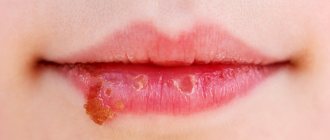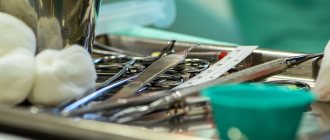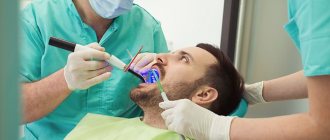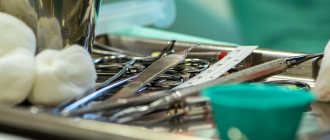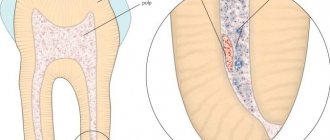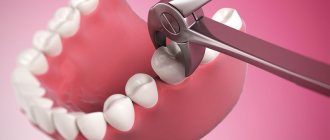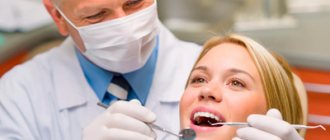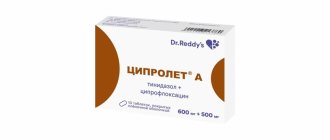Use of NSAIDs in dentistry
From the very beginning of the use of non-steroidal anti-inflammatory drugs, the niches for their use in dentistry have been the most extensive. Let us remember that the substance acetylsalicylic acid, still produced under the brand name 'aspirin', is already more than a hundred years old.
We know that its anti-inflammatory activity and ability to relieve pain is not perfect and varies greatly between individuals. Therefore, the unspoken battle for leadership in pain relief was won by plant alkaloids and poppy opioids - morphine and its derivatives. In those days they already knew about the existence of drug addiction (remember Bulgakov’s “Morphine”), but there were no other means.
The next generation of NSAIDs was Pyramidon, which was used to actively treat headaches and inflammation of the joints.
They began to talk seriously about the use of NSAIDs in dentistry only after 1983, after the discovery of John Wayne. In 1971, he established fundamental differences between groups of NSAIDs, which made it possible to divide into large classes of selective and non-selective. As the name implies, selective ones are able to selectively suppress only pathological enzymes responsible for pain and inflammation. While the latter are capable of blocking both painful processes and physiological reactions, it turned out that blood clotting and pain reactions are very related processes. The difference between triggers is not molecules, but even atoms. Therefore, the key to this process was found only in the last quarter of the twentieth century. With the discovery of truly selective drugs. Only two drugs passed the strict sieve of clinical trials and sanitary restrictions - Celebrex, whose name is taken from the word holiday, which implies relief from pain. The second a little later was Arcoxia, this name came from the Latin language - from the name of one of the joints.
Now that the doctor has drugs in his arsenal that act precisely on the mechanism of pain and do not affect other processes in the body, dentists began to pay attention to these drugs. The spectrum of true dental pathology is very large. Let's start the story with slowly progressing diseases - gingivitis and alveolitis. It is impossible to make such a diagnosis on your own. Only a doctor can make a diagnosis. Your complaints will be pain when chewing, a feeling of unstable teeth and possibly bleeding gums. These signs will be similar to the manifestations of periodontitis and periodontal disease. Anti-inflammatory drugs will primarily relieve swelling and block the release of algogens. Algogens are special molecules, the appearance of which we perceive as painful sensations. Even if you know the cause of the disease and the method of treatment, do not delay your visit to the dentist.
A deeper level of damage is characterized by periodontitis and periostitis, collectively known as “flux.” If you get these diseases, you risk losing your tooth. By using NSAIDs as prescribed by a doctor in combination with other therapy, you will save your teeth and return the normal anatomical proportions of your face.
The third level of use of NSAIDs will consider surgical pathology. Dental surgeries requiring pain relief are common. This is extraction (banal removal) of a tooth, opening of abscesses, maxillofacial surgery after injuries and congenital deformities. These are serious volumetric interventions. And pain relief is used in a complex manner - with different classes of drugs. The use of non-steroidal anti-inflammatory drugs allows you to reduce the dose of local anesthetics and their toxic effect on the heart muscle. In addition, dentists fell in love with highly selective drugs for the possibility of using them as premedication – an hour before the intervention. The advantage of these modern drugs (celecoxib, etoricoxib) is that they do not affect the blood coagulation system. Do not confuse older groups of drugs (nimesulides, diclofenac, naproxen) - their ability to prolong bleeding time and complicate surgical operations has been noted. Speaking about indications for pain relief, we did not mention the fashionable modern trend in dentistry - implantology. The situation depends on the scope of the intervention. If the patient places one implant, then with high-quality preparation of the jaw and gums, massive anesthesia may not be necessary. If we are talking about replacing 4-5 teeth, then it must be considered as a full-fledged operation. As a conclusion, let us mention once again that the main effects expected from non-steroids are pain relief and swelling. In order to achieve these results without side effects on the patient's health, it is recommended to pay more attention to modern selective anti-inflammatory drugs.
1
Medicines in dentistry
Prof. Maksimovsky Yu.M., Ph.D. Chirkova T.D., Ulyanova M.A., Istratova E.V. (MGMSU).
Key points from the speech at the Round Table Ph.D. Chirkova T.D. Department of Faculty Therapeutic Dentistry of Moscow State Medical University
Medicines used in dental practice are conventionally divided into the following groups: 1. painkillers; 2. antibacterial and anti-inflammatory agents; 3. drugs that affect regeneration processes; 4. immunocorrective and immunomodulating drugs; 5. preparations for restoring the microbial landscape of the oral cavity (OR). 1. The main reason for visiting the dentist is pain. The main causes of pain: 1. acute inflammation of the pulp; 2. acute and exacerbation of chronic periodontitis; 3. complications (abscesses and phlegmon); 4. postoperative pain; 5. neuralgic pain. To eliminate acute pain, a fairly large arsenal of drugs for local anesthesia is used. But if the pain is chronic, or it is necessary to reduce pain after dental surgery, local anesthesia alone is not enough and a wider range of medications must be used. In such cases, dentists use non-steroidal anti-inflammatory drugs (NSAIDs). Indications for the use of NSAIDs are: 1. acute and chronic pain; 2. an integral part of the premedication regimen; 3. TMJ diseases; 4. diseases of the trigeminal nerve; 5. periodontal diseases; 6. diseases of the oral mucosa. Clinical pharmacologists blame dentists for recommending NSAIDs to patients, which are highly toxic and can cause severe side effects. It should be borne in mind that many patients who visit the dentist constantly or regularly receive NSAIDs in connection with chronic pain syndrome or as basic therapy for a number of dental diseases. A dentist's knowledge of the pharmacological action and drug interactions of NSAIDs will help avoid serious complications and increase the safety of treatment. The dentist’s arsenal includes NSAIDs with weak anti-inflammatory activity and analgesic effect (for example, mefenamic acid, analgin, metamizole, phenacetin, ketorolac) and NSAIDs with pronounced anti-inflammatory activity and analgesic effect (for example, acetylsalicylic acid (aspirin), sodium salicylate, diclofenac , toltmedin, ibuprofen, ketaprofen, naproxen, indomethacin, sulindac, etodolac, peroxicam, tenoxicam, etc.). The mechanism of action of NSAIDs is due to the blockade of cyclooxygenase COX, a key inflammatory enzyme involved in the regulation of PG synthesis from arachidonic acid. Main pharmacological effects of NSAIDs 1. Anti-inflammatory effect - due to suppression of the exudation phase, in some cases - suppression of collagen synthesis and influence on proliferation processes. 2. Analgesic effect - achieved by inhibiting the synthesis of prostaglandins and stimulating the production of endogenous dynorphin and endorphin, resulting in a decrease in the sensitivity of pain receptors to pain mediators (common and safe relief of mild pain is achieved by using paracetamol and ibuprofen). 3. Antipyritic effect - a decrease in body temperature when it rises and no effect on normal temperature. 4. Antiaggregation effect: inhibition of platelet COX, inhibition of the process of platelet aggregation. Aspirin has the most powerful effect on platelet function, blocking the synthesis of thromboxane for 8 days. When prescribing NSAIDs, patients at risk should be taken into account: 1. Age of patients (patients over 60 years old); 2. Peptic ulcer; 3. Intestinal diseases; 4. Bronchial asthma; 5. Liver diseases; 6. Kidney diseases; 7. Congestive heart failure 8. Chronic alcohol intoxication 9. Blood diseases 10. Patients receiving drugs with which NSAIDs interact. NSAIDs should be taken very carefully in patients with hypertension and diseases of the cardiovascular system. Combination with anticoagulants can lead to the development of hemorrhagic syndrome and hypokalemia. 2. Antibacterial drugs. Their use in dental practice is due to the absolute importance of infection as a factor involved in the development of major dental diseases. Currently, antibacterial therapy is used for the prevention of caries, the prevention and treatment of periodontal diseases, the oral mucosa (OR), to prevent complications that arise during the treatment of destructive forms of periodontitis, the development of transient bacteremia during surgical procedures, as a component of decontamination measures. Antimicrobial agents can be divided into two large classes: 1. Nonspecific antimicrobial drugs 2. Antibiotics. Nonspecific antimicrobial drugs: 1. Chlorhexidine gluconate (0.06 to 0.2%, gels, solutions) 2. Triclosan (bis-phenol, surfactant) 3. Oxygen-containing drugs, hydrogen peroxide 3% 4. Natural compounds (sangviritrin) 5. Miramistin (cationic surfactants) 6. Listerine (phenol-containing essential oils: thymol, eucalyptus, menthol) 7. Medicinal herbs (herbal medicines) Antibiotics 1. group of tetracyclines (tetracycline, monocycline, doxocycline) 2. β-lactam antibiotics (augmentin) 3. macrolides : erythromycin, sumamed, macropen, roxithromycin. 4. lincosamdas: lincomycin, clindomycin 5. imidazoles: metronidazole (Trichopol), nifurtal, tinidazole. 6. fluroquilone antibiotics: ciprofloxacin, norfloxacin 7. fluoroquinolones: nolitsin, siflox, tarivid (especially for patients with diabetes) Drugs for antibacterial therapy must meet a number of requirements: 1. be effective against all specific bacterial pathogens that have colonized the affected areas; 2. enter the affected areas in concentrations sufficient to achieve a bactericidal or bacteriostatic effect; 3. not have local or systemic effects that are significant for the patient’s condition. The route of administration of an antibacterial drug has always been and will be relevant. The question of how to use the drug in dental practice - locally or systemically - remains debatable. The disadvantages of systemic antimicrobial therapy compared to local therapy include the inability to achieve a high concentration of drugs directly in the affected area, the development of allergic reactions, the presence of side effects, and the formation of multiresistant strains of microorganisms. Local (local) use of antimicrobial drugs also has a number of disadvantages. The main problem is the same - creating an effective concentration in the lesion and maintaining such a concentration for the period necessary for treatment. Carriers of drugs for topical use are threads, gels, films. The most commonly used topical medications are tetracycline, doxacycline, monocycline, gramicidin, and roxithromycin. When choosing an antibacterial drug, both the doctor and the patient are faced with the question of the maximum benefit and minimal negative impact of the antibacterial drug on the microflora of the oral cavity. New macrolide antibiotics - clarithromycin, spiramycin, roxithromycin - have a sparing effect against stabilizing species of PR microbiocenosis such as Str.sunguis and some diphtheroids. Modern immunological and microbiological studies have made it possible to evaluate antibacterial drugs in terms of their biological activity. 3. In recent years, there has been a steady increase in the number of PR diseases associated with a violation of the biological balance between the macroorganism and different populations of the microbial flora. Dysbacteriosis is a bacteriological concept that is characterized by a change in the ratio of representatives of normal microflora, a decrease in the number or disappearance of some types of microorganisms due to an increase in the number of others or the appearance of microorganisms that are usually found in small quantities or are not detected at all. According to the degree of severity of dysbiotic shifts (characteristics of the state of the microbial population), dysbacteriosis is distinguished between degrees I, II, III and IV: degree I is characterized by minor changes (this form of shift is called latent or compensated), degree IV is characterized by associations of pathological species of bacteria with yeast-like fungi . The most pronounced disturbances of microbiocosis are observed in patients with lichen planus of the oral mucosa, aphthous stomatitis, candidiasis, glossalgia, periodontal diseases, desquamative glossitis and leukoplakia. Dysbacteriosis of the oral cavity most often occurs and develops in patients with the so-called. secondary immunodeficiency, which often accompanies chronic gastrointestinal diseases, pathologies of the kidneys, lungs, etc. Such patients are often bothered by dry lips, cracks in the red border and in the corners of the mouth, burning and dryness of the oral mucosa; less often - loss of sensitivity of the oral mucosa, enlargement of the tongue, swelling of the oral mucosa, cancerophobia. The main place among treatment methods is occupied by phage therapy with a preliminary determination of sensitivity to phages. (These are coliproteins, klebsial, staphylococcal, streptococcal and pyobacteriophages.) Drugs used in the treatment of candidiasis: the greatest effectiveness (sensitivity of fungi of the genus Candida to antifungal drugs) was revealed by Diflucan, Lamisil, the lowest or weakest effectiveness was shown by nystatin and levarin (according to Prof. Rabinovich I.M., 2003 TsNIIS). In the development of dysbiosis, including COP candidiasis, an important role, in addition to the pathogenicity of the microorganism, is played by the level of the body's resistance, determined by the functional state of the mechanisms of specific and nonspecific defense against infection. Eubiotics and probiotics. Currently, new methods of using drugs containing live bifidobacteria and lactobacilli, which form the basis of normal human microflora, have appeared and are being developed - these are new drugs for restoring the microbiocenosis of the cavities of the human body: “Acilact”, “Bifidumbacterin”, “Lactobacterin”, “Normaze” . In addition to their direct effect, drugs of this group restore the normal microflora of the PR, they have an immunotropic effect (can be used orally or by resorption in the mouth, or directly introduced into periodontal pockets in the form of a paste). 4. Immunocorrective and immunomodulating drugs are drugs without which it is now practically impossible to treat any disease of the oral cavity and periodontium. 4 main directions of immunocorrection: - correction by hormones and mediators of the immune system (thymic factors, myelopeptides, cytokines such as interferon, interleukins, colony-stimulating factors, etc.) - immune engineering (transplantation of organs and tissues of the immune system: bone marrow, fetal liver cells and etc), administration of β-globulins or immunoglobulins of certain classes, blood plasma) - correction with immunostimulants of natural origin (vaccines, lipopolysaccharides, bacterial mixtures), as well as synthetic drugs (levamisole, diucifon, polyanone, etc.) - use of laser or ultrasound irradiation, sorption methods, plasmapheresis. Most often in our practice we use correction with immunostimulants of natural origin, in particular, in the treatment of periodontal diseases and oral cavity, we have accumulated some experience in the use of drugs of microbial, lipopoly- and polysaccharide origin (lycopid, lysozyme, imudon, etc.). Despite the positive factors, immunomodulation can only be used within reasonable limits and with certain restrictions. It should be taken into account that a number of traditional medications, although not related to immunostimulants, but having such properties, can, if not induce, then at least aggravate the onset of immunopathology. Some drugs are endowed with immunostimulating potencies: antibiotics (erythromycin, levorin, nystatin, etc.), nitrofurans (furazolidone). In case of infectious processes, immunomodulators can be prescribed in complex therapy simultaneously with antibacterial therapy, and as monotherapy during the rehabilitation period.
Modern means of professional remineralizing therapy
Modern means of professional remotherapy
Let's talk about a very interesting topic that raises many questions.
Remineralizing therapy (remotherapy) is a set of measures aimed at restoring tooth structure by saturating the enamel with microelements.
The main substances that participate in this process:
- Calcium.
- Fluorine.
- Medical nano-hydroxyapatite.
What indications exist for remotherapy?
- Protection of teeth after professional oral hygiene.
- Initial forms of caries.
- Prevention of caries.
- Non-carious lesions (hypoplasia, erosion, wedge-shaped defects, increased tooth wear, etc.) - in this case as part of a complex treatment.
- Increased sensitivity of teeth (hyperesthesia).
- Microcracks and microdamage to enamel.
- Orthodontic treatment (before treatment, during and after).
- Teeth whitening (as a prevention of hypersensitivity and protection of tooth tissue).
Types of remotherapy:
- Home
This is the doctor's prescription of special medications for use at home, depending on the specific clinical situation.
Sometimes combined with professional remotherapy.
Therefore, it is important to consult with your doctor to choose the optimal remotherapy regimen that is right for you and will allow you to achieve effective results.
It is also mandatory to carry out professional hygiene (removing plaque from the surface of the teeth) before starting therapy.
- Professional
Conducted by a dentist in a dental clinic.
Professional preparations are used here, which require special application technology.
So, let's figure out what products are used for professional remotherapy.
As a rule, these are preparations of fluorine and nano-hydroxyapatite.
Fluoride preparations
They can come in various forms: gel, varnish, suspension or liquid.
Fluoride gel
The main ingredient is dissociated fluoride ion. The mechanism of action is based on a chemical reaction: fluoride ion interacts with hydroxide ions of tooth enamel, which leads to the formation of a more durable compound, thereby achieving a remineralization effect.
Fluorine also has an antibacterial and hyposensitizing (reduces hypersensitivity) effect.
Therefore, fluoride gels must be used after professional oral hygiene in order to protect the enamel until pellicle (a natural film covering the teeth, which forms after a few hours) is formed.
Also, such gels are used during orthodontic treatment (for the prevention of caries), with increased sensitivity of teeth, as well as in complex therapy with calcium preparations. The gel is applied to the teeth using special trays.
Suspensions and liquids
These drugs have two bottles.
In the first bottle: a liquid saturated with fluorine, copper, magnesium ions, in the second - a suspension of calcium hydroxide.
The mechanism of action is also based on a number of chemical reactions. As a result, demineralization of enamel is inhibited, remineralization occurs, and also has a bactericidal effect.
These products are able to penetrate deeper layers of enamel and are used for more serious damage. But this requires adherence to an algorithm for sequential application of the drug to achieve results.
Fluoride varnish
This is a quick-drying varnish that forms a film on the surface of tooth tissues, which well isolates enamel and, especially, dentin, which can release fluoride for a long time.
These forms of fluoride are most often used in the presence of non-carious lesions (wedge-shaped defects) accompanied by increased sensitivity.
Medical nano-hydroxyapatite
This is a specialized paste based on a high concentration of nano-hydroxyapatite - a synthesized substance whose chemical composition is identical to tooth tissue. The particles have a tiny size, which allows them to penetrate into the deeper layers of the enamel and integrate into its structure, which increases the remineralization effect (unlike fluorides, which work in more superficial layers).
Therefore, Apadent Pro is successfully used:
- After professional teeth cleaning.
- Before and after installing braces, after removing braces (when white spots often appear - areas of demineralization).
- Before and after professional whitening.
- In order to prevent enamel health.
- With increased demineralization during pregnancy.
- For children to prevent caries.
- For microcracks and enamel damage.
Apadent Pro is completely safe and has a short effective exposure period. Depending on the clinical situation, the effect may be noticeable after one application! But sometimes (for example, multiple white spots, severe damage to the enamel of carious and non-carious origin, cracks) several visits to the dentist or even the use of this paste at home as prescribed by a doctor are required to maintain the result. On average, the effect lasts about six months, again it all depends on the initial situation and individual characteristics.
This preparation is applied to the teeth using a special polishing rubber and requires a certain mode of rotation of the tip. All tooth surfaces are treated, including contact areas!
Each drug has its own advantages and will be optimal in a certain clinical situation. At the appointment, the doctor assesses the condition of the dental tissues and selects the necessary remotherapy regimen. Therefore, it is important to regularly carry out professional oral hygiene and preventive measures, which will help maintain a beautiful and healthy smile for many years!
